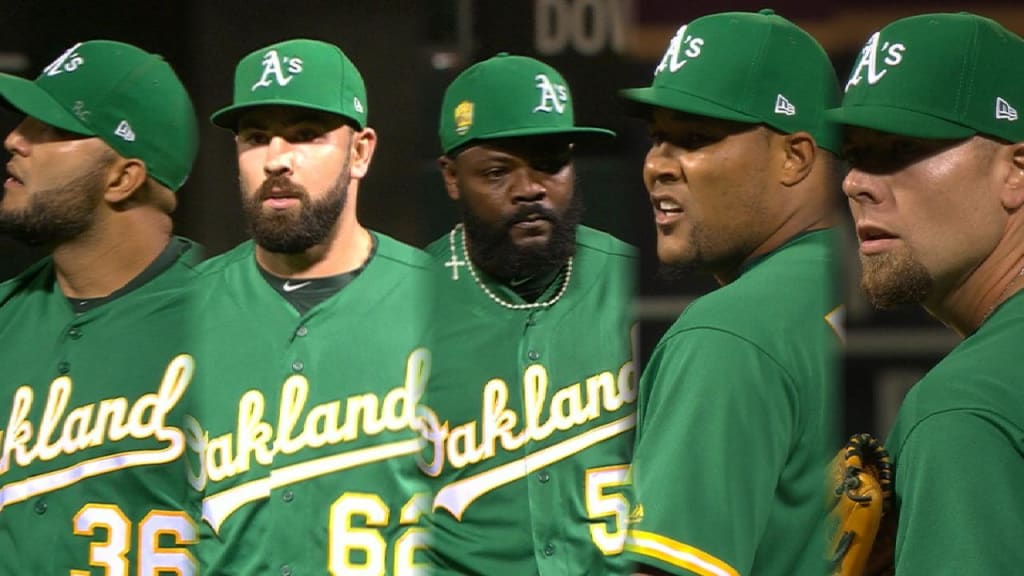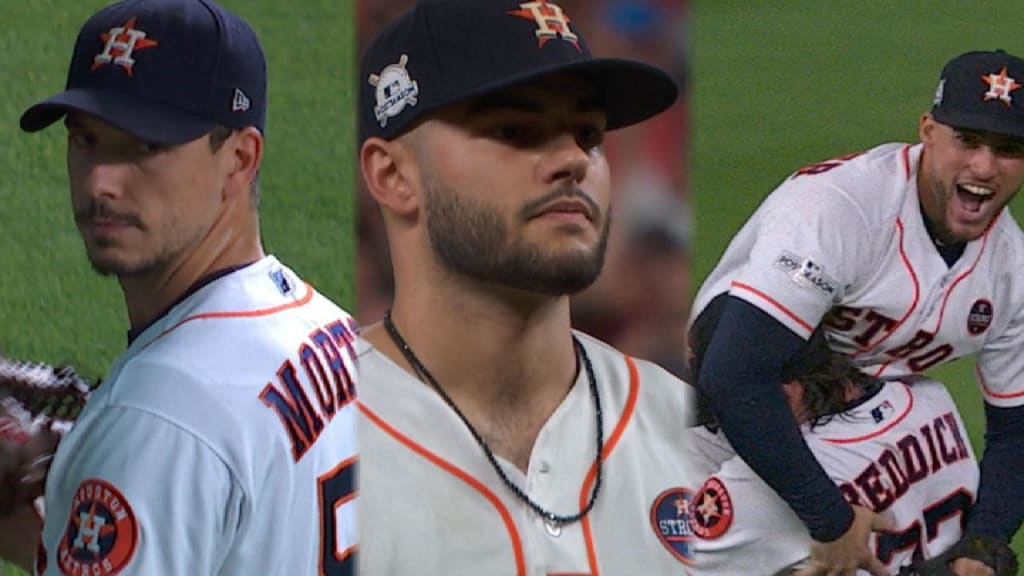Could the 'opener' be utilized in postseason?
This browser does not support the video element.
How much of the "opener" will we see in the postseason? That it's a permanent part of baseball is no longer even a question. Yes, it's different from anything we've ever seen in baseball. It also works.
Since the Rays rolled it out for the first time in mid-May, they're 66-48 with the second-lowest ERA in the Majors (3.38). Others have tried it -- some out of necessity, some seemingly out of curiosity.
One thing is clear: It's here to stay.
"Some form of [it] is the future of baseball," Seattle Mariners general manager Jerry Dipoto told USA Today. "It's just a matter of the extremity."
Here's how it works: A short reliever pitches the first inning, followed by a more typical "starting pitcher" to attempt to get the game into the fifth or sixth inning. After that, it's the normal parade of relievers to finish the deal.
The opener tactic shouldn't be confused with a normal "bullpen" game, which teams have used for years. In those, it's all relievers, each going an inning or so before giving way to another reliever. However, the reason the opener has succeeded seems to have emboldened teams to use more bullpen games for some of the same reasons.
The Oakland A's are still working through their options for the American League Wild Card Game against the Yankees, but don't be surprised if they opt for an opener or turn over the whole game to their relief corps given that Oakland's bullpen is one of baseball's best.
"We play to our strengths," A's manager Bob Melvin said. "Are we going to let a starter go out there and give up six runs? We're not going to let that happen. It took us a little while to get used to it, because it was different. It has gone well, and guys are more comfortable with it."
Playing to his strength is what Astros manager AJ Hinch did so smartly last October when his team won a World Series despite a shaky bullpen. Hinch used all but one of his starting pitchers in relief at least once.
In Game 7 of the AL Championship Series, Charlie Morton pitched five shutout innings against the Yankees before Hinch turned to another starter, Lance McCullers Jr., for the final four of a 4-0 victory.
This browser does not support the video element.
And then in Game 7 of the World Series, the roles were reversed as McCullers pitched 2 1/3 innings at the start, and Morton went the final four.
"I think what creates the bullpening effect, or using a lot of different pitchers, is the sense of urgency," Hinch said. "The sense of urgency is never greater than it's going to be in the playoffs. We saw that last year in the World Series.
"I think it'll carry over because that's the way you win a short series ... constantly try to use your weapons the best you can. That's leaked into the [regular] season a little bit. Some teams have done it longer than others, and your team has to be set up to do that.
"I think that's largely what September baseball has turned into. A sense of urgency is driving decisions earlier and earlier in games."
The Rays had discussed such a tactic for a couple of years before actually running out late-inning specialist Sergio Romo to pitch the first inning against the Angels and their predominantly right-handed-hitting lineup on May 19.
This browser does not support the video element.
Tampa Bay officials say they were, like the A's, playing to their strength. The Rays do not use an opener when 21-game winner Blake Snell gets the ball, and baseball people are adamant that teams will still look, first, for a dominant starter to go deep into games.
"I'm skeptical we're going to see much of it during the postseason," Astros president of baseball operations Jeff Luhnow said. "Most teams have at least two or three starters that they want to be out there, and they're going to be out there twice in a five-game series, maybe even three times in a seven-game series. Maybe we'll see it, but I think we're going to see traditional [methods]."
He points to the Indians, with Corey Kluber and Trevor Bauer, and to his own club with Morton, Justin Verlander and Gerrit Cole.
On the other hand, as Dipoto said, this season has seen an evolution. Here's what's behind the opener:
1. Treating the first inning like the ninth
The first inning is the highest-scoring inning in most baseball games. The ninth is the lowest scoring by a wide margin. Why? In the first inning, lineups are set up perfectly and starting pitchers many times are looking for their rhythm.
In the ninth inning, managers turn to their high-velocity, short-appearance closers. So why not bring in a pitcher accustomed to one-inning, high-leverage situations and keep an opponent from scoring in the first inning?
2. Allows a starting pitcher to face an opponent's best hitters one fewer time
Here's what happens as a pitcher works his way through an opponent's batting order multiple times:
First time: .242 BA, .712 OPS
Second time: .252 BA, .734 OPS
Third time: .266 BA, .786 OPS
Fourth time and beyond: .281 BA, .781 OPS
"If you can face Mike Trout one less time, that's to your pitcher's advantage," Luhnow said.
These are the averages across baseball entering play Wednesday. If your starting pitcher is Verlander or Chris Sale, you do not remove him after he has faced every hitter twice. On average, though, allowing a starter to go through a lineup no more than twice is the optimal scenario.
The Brewers carried this theory to the extreme Monday when they used lefty reliever Dan Jennings to start the game and face one hitter: Cardinals leadoff man Matt Carpenter.
This browser does not support the video element.
3. Hitters are creatures of habit and not accustomed to facing, say, a different pitcher each at-bat
"I think that's a part of it," said Chaim Bloom, Tampa Bay's senior vice president of baseball operations. "By having a reliever begin the game, you can create different looks for the opposing hitters early on that may be unsettling for them and make it harder for them to get in the flow of the game.
"And then you also make it easier for the starter to pitch deeper in the game without running him out past the point where he can have success, and then turning a lead over to the bullpen to finish it."
In all the explanations of this strategy, "unsettling" may be the single most accurate word used.
Bloom: "I think it's that old quote from [Hall of Famer] Warren Spahn: 'Hitting is about timing, and pitching is about upsetting timing.' I think this is an offshoot of that. Any way that our pitching staff can make hitters less comfortable, I think that's something we've got to look into."
Hinch added: "Yeah, it's uncomfortable. It's uncomfortable to face four pitchers in your four at-bats. You like familiarity. Every time we talk about matchups, we talk about what they've done in the past or what we think they're going to do now. Hitters don't like it."
4. Utilizing an organization's talent
Instead of a team having its best young arms in the Minor Leagues building arm strength and endurance, why not have them in the Majors honing their craft with shorter appearances?
This is not new. The Orioles, for instance, in the 1970s and '80s, allowed their best young starters to get acclimated to the Major Leagues by working from the bullpen for a season or two before joining the rotation.
This is baseball's new normal. That is, bright people willing to think outside the box and try things that might work instead of adhering to tradition.
"I think this was sort of a natural evolution of some of the conversations that we have had as a staff between the front office and the coaching staff, really dating back prior to this year," Bloom said. "The opener was kind of the next step in that evolution.
"I think one of the nice things about where we've gotten with it -- and really has been very collaborative -- is the idea of getting the most out of our pitchers and always looking for ways to put them in better position to succeed, and by doing, putting us in better position to succeed."

